- TableTalkAI
- Posts
- 🤖🍳 Robo-Chefs and the Future of Flavor: Will AI Take Over the Line?
🤖🍳 Robo-Chefs and the Future of Flavor: Will AI Take Over the Line?
AI-driven robots are clocking in at restaurant kitchens
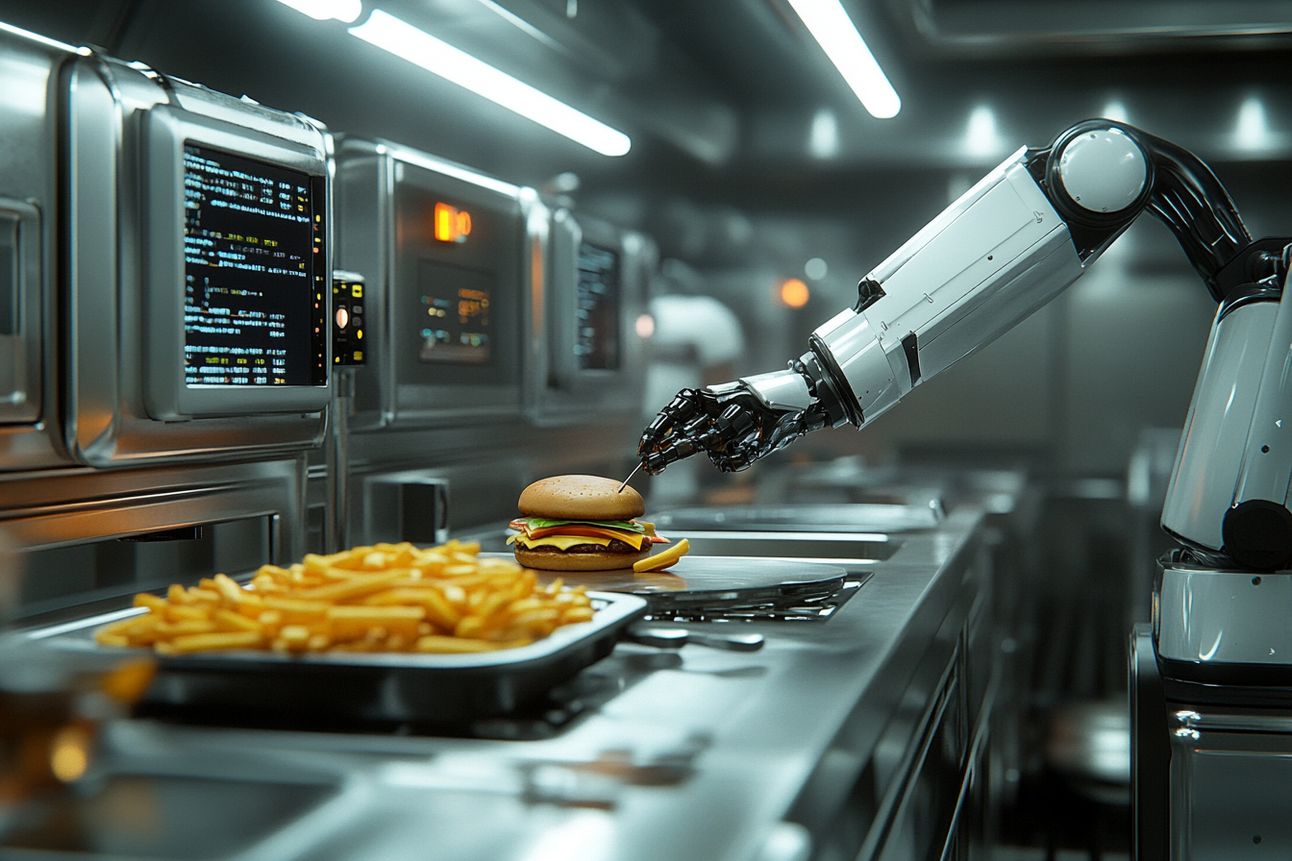
Find out why 1M+ professionals read Superhuman AI daily.
In 2 years you will be working for AI
Or an AI will be working for you
Here's how you can future-proof yourself:
Join the Superhuman AI newsletter – read by 1M+ people at top companies
Master AI tools, tutorials, and news in just 3 minutes a day
Become 10X more productive using AI
Join 1,000,000+ pros at companies like Google, Meta, and Amazon that are using AI to get ahead.
On a late-night burger run not too long ago, I was greeted not by the usual line cook in a grease-splattered apron, but by a robotic arm calmly dunking fries. It sounds like a sci-fi flick, but welcome to 2025 – AI-driven robots are clocking in at restaurant kitchens. From salad-making conveyor belts to burger-flipping bots, the robo-chef revolution is underway. Sweetgreen recently launched its first Infinite Kitchen in Naperville, Illinois – a fully automated makeline that came out of its acquisition of the Spyce robotic kitchen startup. White Castle has been deploying “Flippy,” an AI-powered fry cook, in dozens of locations and reports it as “a win,” boosting kitchen speed and order accuracy. In fact, when Flippy 2 is let loose on the fry station, it can produce 30% more fries than a human fry cook.
Not to be outdone, Chipotle is experimenting with an “Autocado” robot that cuts, cores, and peels avocados in just 26 seconds – part of a high-tech guacamole-making assist that could save them significant prep time. These real-world examples aren’t just tech showcases; they promise improvements in efficiency, consistency, and cost control. But they also spark big questions: What does this mean for the crew in the kitchen, and for the soul of hospitality itself? Before we start envisioning C-3PO in a chef’s toque, let’s break down the implications of AI robots replacing kitchen staff – with a candid eye on both the benefits and the heartburn.
Impact Analysis 💥📈
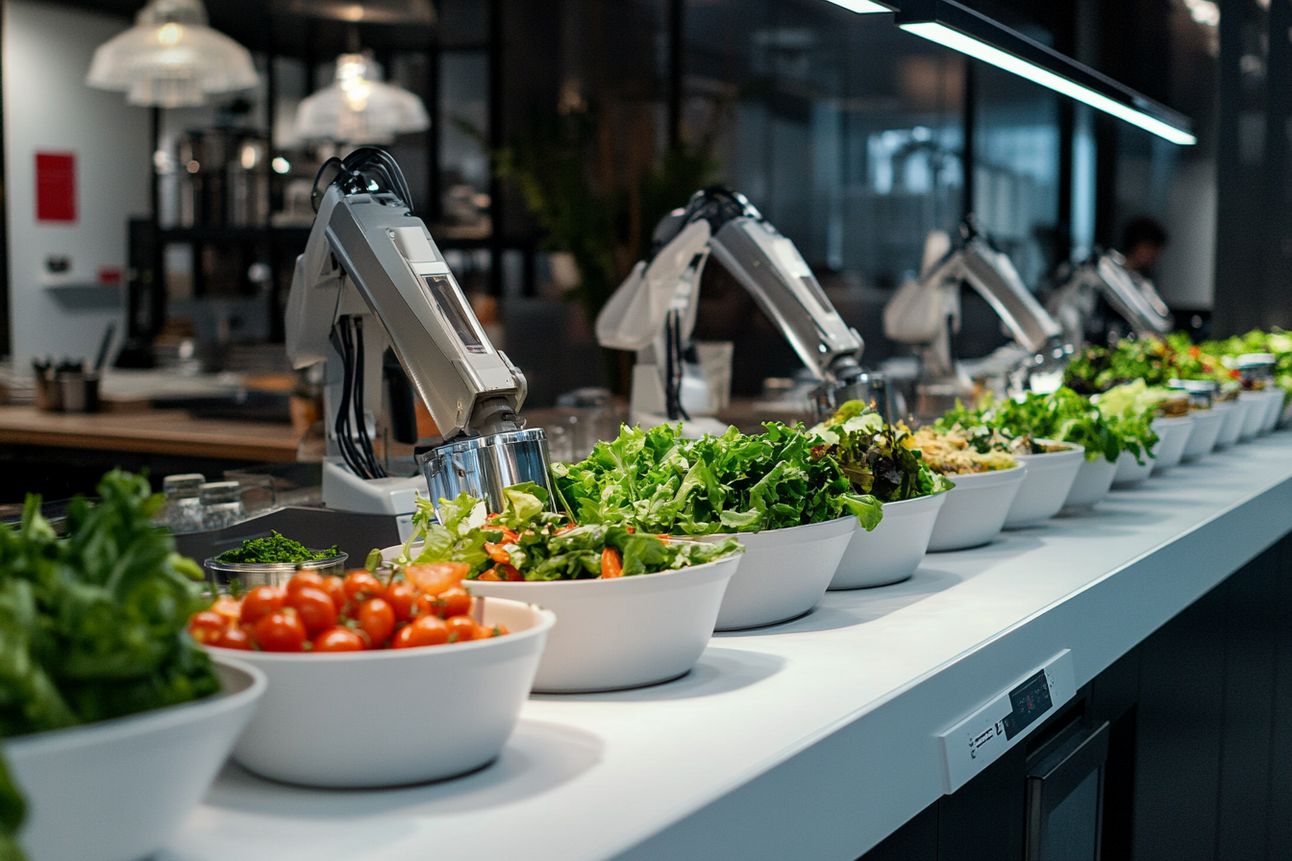
Restaurant veterans will tell you that speed, cost, and consistency are the holy trinity of back-of-house operations. AI kitchen robots aim to hit all three:
Operational Efficiency: One of the biggest selling points of robo-chefs is turbocharged output and endurance. A robot never needs a cigarette break or a midnight snack, and it won’t call out sick on a sunny Friday. In practice, these machines can seriously amp up throughput. White Castle’s Flippy robot, for instance, can fry basket after basket in a perfectly repeatable rhythm – when allowed to work at full tilt, Flippy 2 increased fry cooking output by about 30% compared to human workers. Over at Sweetgreen’s new automated location, the Infinite Kitchen reportedly assembled nearly 200 salad bowls in just 30 minutes during a test run, with 100% of orders ready on time, and has the potential capacity to crank out up to 500 bowls per hour during peak times. (For comparison, even the fastest human salad line would be hard-pressed to hit those numbers.) Speed aside, robots can operate in scalding fryer oil or over a grill for hours without tiring, which means a more consistent pace during the lunch or dinner rush. They’re precise timers and tireless workers – ideal for the repetitive, high-volume tasks that often bottleneck a kitchen. And while human cooks might lose focus on burger number 200 of the day, a robot stays as sharp on the last order as on the first. The result is potentially shorter ticket times and an ability to handle late-night or overflow orders without breaking a sweat (not that robots can sweat). In industries like fast food where efficiency is king, that’s a tempting proposition.
Cost Implications: Labor-saving technology is expensive – but so is labor. The calculus of whether a robot sous-chef pays off comes down to both hard numbers and soft benefits. Upfront, a kitchen robot can require a hefty investment (tens of thousands of dollars) or a subscription-like rental fee (Miso Robotics offers “Flippy-as-a-Service” at ~$3,000 a month). That sounds steep but consider the rising cost of human staff: in California, fast-food chains now face a $20/hour minimum wage (with further increases on the horizon), which makes automation more financially attractive by the day. Each Flippy unit, for example, can handle work often done by two fry cooks, allowing one of those staffers to be reassigned elsewhere – effectively halving the labor needed at that station. Over time, that can translate to significant savings, especially as robot prices fall and human wages climb. Early data from Sweetgreen’s automated store bears this out: the location pulled in healthy sales and hit 31% restaurant-level profit margins in its first year, notably higher than typical store margins, while its employee turnover was 45% lower than a standard location. Fewer grueling prep tasks meant happier (and thus more stable) employees, and likely lower training costs from constant rehiring. Higher efficiency can also boost revenue – Sweetgreen saw a roughly 10% increase in average ticket size during its robot kitchen tests, possibly thanks to faster throughput and perhaps a bit of “wow” factor prompting add-on orders. There are hidden costs to weigh, of course. Maintenance, repairs, and downtime for these gadgets can be significant – they’re machines that will break or require software updates. One illuminating example is Chipotle’s earlier test of “Chippy,” an automated tortilla chip fryer; it turned out that the extra setup and cleanup work offset much of the labor savings Chippy provided. In other words, if your high-tech avocado-slicer needs a full-time technician or slows you down with cleaning requirements, the ROI equation changes. Nonetheless, as the tech matures, analysts predict automated kitchens will yield higher returns over time due to lower labor costs and greater output. In fact, industry watchers note that the gap in ROI will widen as labor expenses keep rising and automation equipment gets cheaper and more efficient. It’s a long-term play: invest now to save later. If done right, automation could trim operating costs, reduce errors (which are costly too), and even enable new revenue (like late-night service that was previously impractical). Still, every operator eyeing that shiny robot must ask: will this gizmo actually cut costs, or just become an overpriced staff member with its own demands?
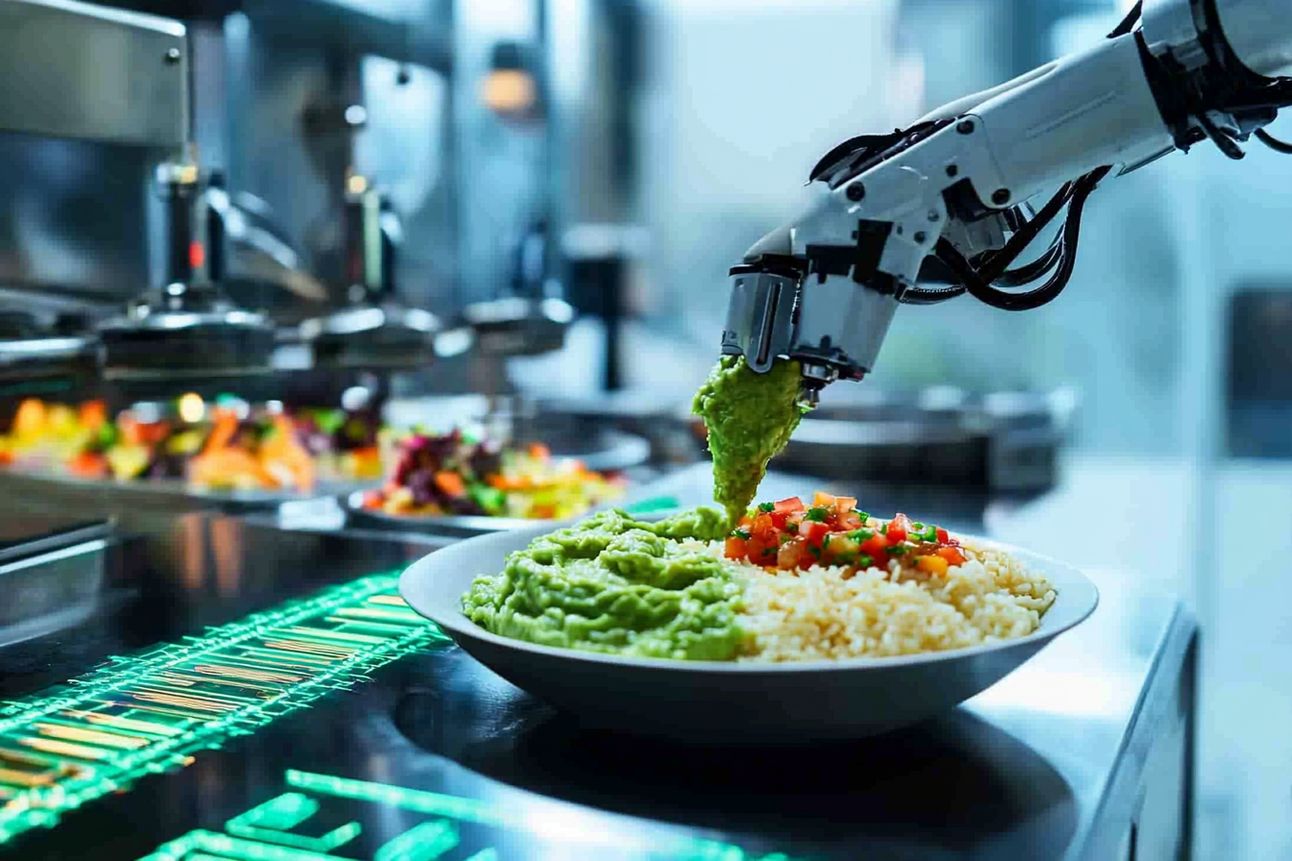
Quality Control: Consistency is the secret sauce of any successful restaurant, and here robots really shine (sometimes literally, as they are made of stainless steel). AI cooks are programmed for precision – they don’t “pinch of salt” their way through a recipe or have off days where the burger is a tad undercooked. For example, Chipotle’s trial of the Hyphen automated makeline (a kind of collaborative robot line) uses intelligent dispensers that drop pre-set portions of each ingredient into your burrito bowl, ensuring you get the same scoop of guac and sprinkle of cheese every time. No more human variability where one day your bowl is brimming and the next it’s skimpy. White Castle has similarly noted that Flippy helped improve order accuracy in their stores – the robot follows its programmed steps exactly, so if it’s told to put fries down for 3 minutes, it’ll do so every single time. That level of standardized execution can tighten quality control and reduce waste (overcooking or errors lead to thrown-out food). Moreover, automation can enhance food safety and hygiene. Fewer human hands on the product means fewer chances for hair, sneezes, or other unappetizing surprises in your meal.
A robot like Flippy works in a closed system, which helps reduce cross-contamination risks and maintains a cleaner fry station. And let’s face it – a machine isn’t going to sneak a quick taste or double-dip the spoon. There’s also an argument that robots enable higher-end quality techniques to be scaled. Imagine every steak cooked exactly to medium-rare perfection via an AI grill sensor, or sauces simmered at a precise temperature for the exact right duration. These are the kinds of quality gains that make engineers giddy. Sweetgreen’s CEO, Jonathan Neman, highlighted that their Infinite Kitchen directly tackles the company’s weakest points in consistency – portioning, accuracy and timeliness – thereby boosting customer satisfaction and loyalty. In theory, when every dish is prepared to spec and on time, guest complaints drop and those hard-to-measure elements like “flavor balance” and presentation become reliable across locations. Of course, cooking is also an art, and a robot’s perfection can be a double-edged sword; the char on a burger or the toss of a wok can be a bit too uniform, losing the delightful quirks of a human touch. We’ve yet to see an AI that can “season to taste” the way a Grandma or a genius line cook can. But for many routine tasks, especially in fast-casual and QSR formats, the appeal of minimized human error is huge. Robots won’t forget to hold the pickles or accidentally dump salt twice. The food is “fried to automated perfection” every time – and if something’s not right, well, that’s on the programmer, not the guy on grill who had a bad day.
Employment Concerns 🚨📉👷♂️
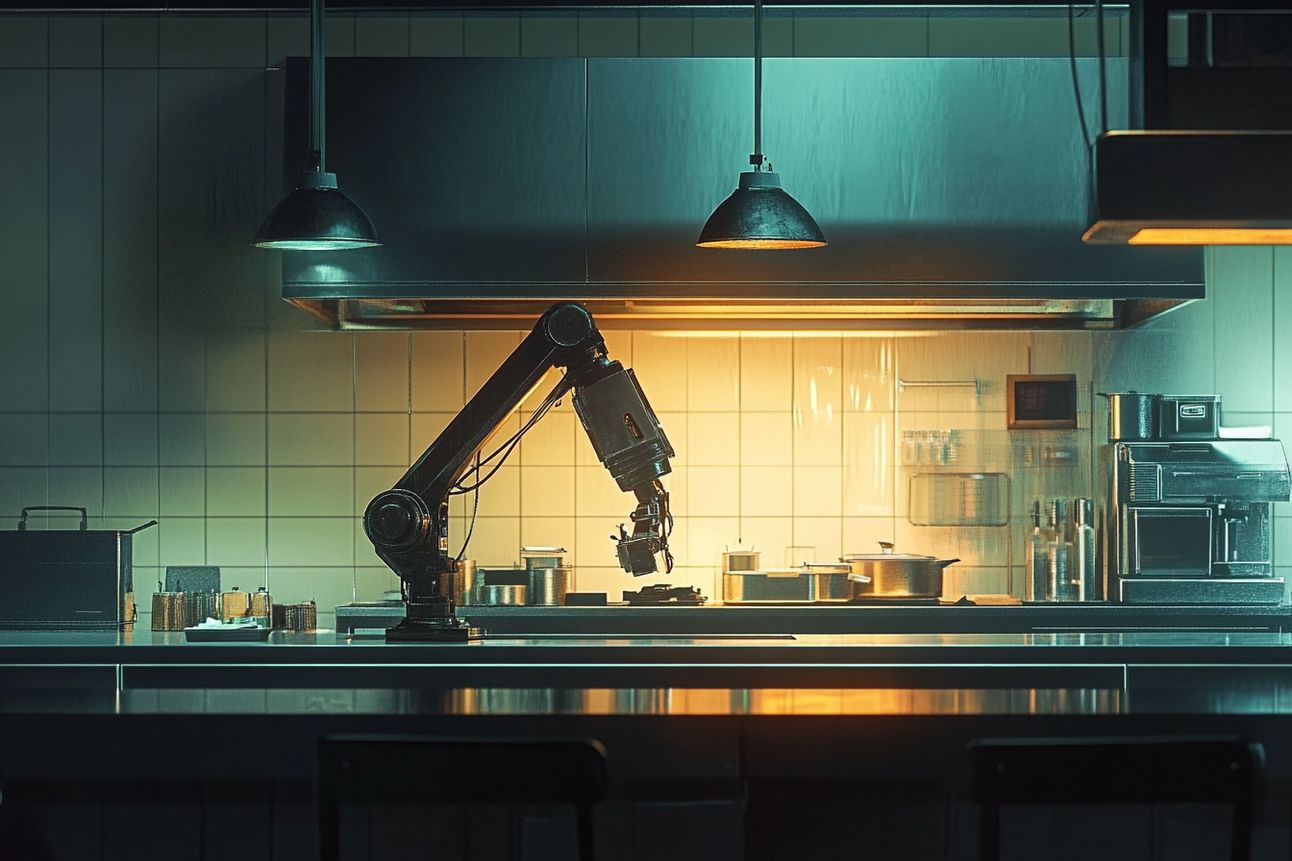
Walk into any restaurant kitchen and you’ll see a tight-knit crew of humans hustling – that human element has always been central. So what happens to our fellow cooks and prep wizards if R2-D2 joins the team?
Job Displacement: There’s no sugarcoating it – some roles are at risk. The very point of kitchen automation is to handle repetitive, low-level tasks more efficiently, which by definition means fewer people needed to do them. Robots excel at flipping burgers, dropping fries, stirring sauces, and assembling bowls, so it’s the line cooks and prep cooks performing those repetitive tasks who face displacement. As one industry observer bluntly put it, “AI will replace jobs where tasks are highly repetitive”, and kitchen work has plenty of those. We’re already seeing it: Sweetgreen’s Infinite Kitchen doesn’t require the usual squad of salad line workers in front of the customers – one employee can load ingredients into the robot while the machine does the assembling that used to occupy 3-4 people. White Castle’s fry stations traditionally had two people: with Flippy, they’ve been able to staff just one person alongside the robot. Extrapolate that across 100 robots, and that’s potentially 100 fewer human fry cooks. For restaurant owners, that reduction is part of the appeal; for workers, it’s understandably frightening. The fast-food and fast-casual sectors employ millions of people in the US, often as entry-level jobs – if widespread automation comes, there’s a real concern about where those workers will go.
History tells us that when automation arrives, some jobs do vanish. And unlike past waves of tech (say, self-checkout kiosks or order-at-table tablets) that shifted workers into other customer service roles, kitchen robots go right to the heart of back-of-house labor. There’s an immediate “people versus machines” narrative that makes for uneasy optics and, more importantly, real human impact. We also have to consider the ripple effects: if one robot can handle the output of 2-3 line cooks, that might slow down hiring in new restaurant openings or reduce hours for the existing staff. In an industry that has traditionally offered a foothold on the job ladder for many (first jobs, jobs for non-college folks, etc.), this shift could be significant. To put it in perspective, turnover in fast-food kitchens is nearly 100% annually – these are tough jobs that many workers don’t stick with. Automation could alleviate the hiring crunch by reducing the number of bodies needed, but it also means those who would cycle through those jobs might find the positions gone altogether.
The cold truth is, once technology proves it can do the job reliably, you can’t put that genie back in the bottle. We’re not going back to elevator operators or switchboard callers, and we likely won’t return to entirely human fry cooks once robots become cheap and common. That has economists and labor advocates concerned about displacement on a large scale, and rightly so. In the short term, there may be a mismatch: workers who lose a kitchen job might not easily slide into a new role if they lack other skills. There’s a growing call for companies and governments to invest in reskilling programs – to train displaced cooks for the kinds of jobs humans will still do (more on that in a moment). It’s a transition that won’t be painless for everyone. The bottom line: yes, some human kitchen jobs will be lost or fundamentally changed because of AI and robots. As a hospitality industry lifer (and “people-first” believer), I don’t take that lightly. But it’s also not the end of the story.New Opportunities: Here’s the flip side of the coin – for every role a new technology eliminates, new roles tend to emerge. They might not appear overnight, and they might require different skills, but history suggests that automation shifts labor rather than destroys it completely. So, what new hats might restaurant workers wear in the age of AI kitchens? For starters, someone has to build, program, maintain, and fix all these fancy robots. There’s already demand for robot technicians and maintenance specialists – think of it as the rise of the “robot mechanic” within the restaurant team. (Perhaps tomorrow’s equivalent of a lead line cook is a tech-savvy “robot supervisor” who knows both cooking and coding.) Moreover, when routine tasks are automated, humans can be redeployed to more guest-facing and creative roles. Remember that at White Castle, Flippy didn’t outright replace the second fry cook – it allowed that person to move to the drive-thru window or handle more customer service tasks. At Sweetgreen’s automated store, the employees who used to stand making salads can now focus on greeting guests, answering questions, and generally enhancing the hospitality aspect of the experience. In a way, the robots are doing the mechanical work so that humans can do the human work.
There’s a real opportunity for staff to level-up their roles – becoming technology coordinators and hospitality ambassadors rather than assembly-line workers. One could envision an employee overseeing a fleet of kitchen robots across a region, essentially becoming an on-call specialist (a job that might command higher pay than a typical line cook, by the way). Also, as AI tools spread, new positions are emerging in data analysis and inventory management. A kitchen robot might generate a ton of data on cooking times, ingredient usage, etc., and savvy restaurants will need people to interpret and act on those insights. Training roles can evolve too: instead of training people how to chop lettuce, you might train them how to work alongside an automated system, how to do quality control on its output, and how to keep it sanitized and stocked. Forward-looking folks in the industry note that AI integration will be needed at all levels – from unit-level operations to corporate strategy – and hospitality workers can be retrained to fill those tech-enabled positions. For example, a former burger flipper could become the go-to person to troubleshoot the burger-flipping robot and be the one who steps in to handle custom orders or special requests that the machine isn’t programmed for. In essence, their job description shifts from manual labor to a mix of technical oversight and customer care. And let’s not ignore the most human skills: creativity and personal connection. Even the fanciest AI doesn’t (yet) create new recipes out of thin air or charm a guest with a great story about a dish’s origin. We may see more culinary curators and experience curators on staff – humans who use the time saved by robots to infuse more hospitality into the business. As mundane prep work gets off-loaded, perhaps the line cook of the future spends more time perfecting that new sauce or interacting with guests at an open kitchen “chef’s counter.” It’s a hopeful outlook, but not an unrealistic one. The hospitality industry has always adapted – think about how jobs have changed with online ordering, delivery, and all the tech of the last decade.
Many of us believe that while AI will indeed displace some tasks, it will also create avenues for workers to step into higher-value functions. In fact, some restaurateurs argue that this could help elevate the profession: freeing employees from drudgery to focus on aspects of service that only humans can do best (like making customers feel welcome). The transition won’t be seamless – there will be winners and losers – but if we approach it right, today’s line cook could be tomorrow’s robot concierge or AI-enhanced chef. As one industry newsletter noted recently, historical patterns show tech revolutions often lead to labor reallocation rather than permanent net losses. The tasks shift, the work changes form, and new kinds of jobs emerge. Our challenge in hospitality is making sure we help our people make that leap, so that the coming robo-kitchen era is one of empowerment and not just unemployment.
Customer Experience 😊💬⭐
If a robot cooks in the kitchen and no one is around to see it, do customers care? In other words, how does all this automation impact the front-of-house vibe and diners’ perceptions? After all, a restaurant isn’t just a food factory – it’s a theater of experience.
Service Interaction: In some ways, a robotic kitchen could be almost invisible to customers. If you walk into a restaurant and order via a kiosk or your phone, you might only vaguely notice that the folks assembling your bowl or flipping your burger are machines behind a glass partition. But many restaurants pride themselves on an open kitchen or at least the energy that emanates from the back-of-house. The sights, sounds, and smells of a busy kitchen are part of the ambiance – the flare of a wok, the chatter of cooks calling “Order up!” and the flames leaping on the grill. Replacing human cooks with robots can change that atmosphere. It might be quieter, more mechanical, almost eerily efficient. Some guests will find it fascinating: a bit of dinner entertainment watching a robot arm dance around the griddle. (I suspect more than a few family dinner decisions will be made with kids begging, “Can we go to the robot restaurant, Dad?” at least initially.) In fact, early robot kitchen experiments did draw crowds of curious onlookers – when CaliBurger installed the first Flippy on a grill in 2018, so many customers came to watch the poor thing that it actually slowed down service and had to be temporarily taken offline to recalibrate. Novelty has a strong pull. But after the novelty wears off, would an all-robot kitchen feel cold or soulless? That’s a concern some in the industry have voiced. Food is emotional; it has soul. We connect it with the people who cook it. Think of the sushi chef’s deft hands preparing nigiri, or the grill master who chats with you while searing your steak. Robots don’t provide that kind of heart. To mitigate this, some brands deploying automation are consciously keeping a human element in the guest interaction. Sweetgreen, for example, didn’t just open an automated location and cross its fingers – they introduced a new “host” position at the front of their Infinite Kitchen store, whose job is to greet guests, guide them through the digital ordering process if needed, and basically add a personal touch to the high-tech experience. The idea is that even if a machine is assembling your salad, a friendly human is still on hand to smile, answer “what’s in the dressing?” and maybe talk about the local farm that grew your lettuce.
Similarly, other restaurants might keep chefs or expediters visible to garnish plates or do final seasoning in front of guests, maintaining the feeling that people are still very much involved in preparing your meal. There’s also the aspect of service speed and customization – a well-programmed robot might actually improve the customer experience by delivering orders more accurately and quickly. Fewer messed-up orders can mean a happier dining room overall. But if a problem does occur (“Excuse me, this soup is cold” or “I asked for extra salsa”), how the restaurant handles it matters. Ideally, freeing up staff from the kitchen means more staff available in the dining area to handle such issues promptly and personably. A robot isn’t going to apologize for a mistake or comp your dessert, but a human employee who isn’t swamped with eight tickets on the grill just might have the bandwidth to give great tableside service. In that sense, a robotic kitchen could enhance hospitality by allowing humans to do what humans do best – interact and empathize – while machines quietly hum in the back making sure the hard-shell tacos don’t burn. The balance of visible hospitality versus hidden automation is something each restaurant will need to find. Some might choose to put the robots on display as a feature; others might hide them away like a dirty secret so the restaurant feels traditional to guests. There’s no one-size-fits-all answer, and it likely depends on the concept. A trendy fast-casual spot catering to Gen Z foodies might lean into the futuristic vibe, whereas a fine dining restaurant would be wise to keep the grandma stirring the soup (even if grandma is secretly a robot under the lid).Consumer Perception: The million-dollar question: Will customers embrace robot-made food, or will it turn them off? So far, the response has been mixed. On a practical level, diners generally care most about price, taste, and speed. If automation can help deliver a hot, tasty meal faster and maybe a bit cheaper, many patrons will cheerfully accept it. Indeed, surveys show that consumers appreciate things like faster service and see potential value in automation – one recent study found a lot of people are perfectly fine with automated ordering or payment processes, which they view as increasing convenience. However, when it comes to the actual food preparation, people get more nervous. More than half (55%) of global consumers in one survey said that fully automated food prep is “unacceptable” in both quick-service and full-service restaurant settings. That indicates a real hesitation about having no human chef at all in the kitchen, even at a fast-food joint. There’s also an emotional undercurrent: 94% of diners say that human customer service is important to their restaurant experience, with 67% calling it very important. We are, it seems, still wired to want people involved in our dining rituals. A robot might make your burrito bowl flawlessly, but it won’t ask how your day is going or crack a joke about “extra guac.” For some guests, that’s just fine – they’d trade chit-chat for accuracy any day. For others, it erodes the warmth of eating out. The perception of a restaurant can also shift if it goes heavy on automation. A place known for hospitality might risk appearing cold or impersonal if suddenly half the staff is gone.
There’s an interesting example with Chick-fil-A: this brand is famous (even memed) for its ultra-friendly, above-and-beyond service culture. They’re testing a new cashier less, mostly automated store format in some markets, but observers have noted this “radical departure” could clash with what made Chick-fil-A beloved in the first place. If your brand is built on a smile and a warm welcome, going robot-heavy might actually rub loyal customers the wrong way. It’s not just about the food quality; it’s about what the restaurant stands for in the public eye. In an era of economic uncertainty, a restaurant that appears to be firing workers to put in robots might also face a customer backlash on ethical grounds. The last thing you want is guests feeling guilty or uneasy that their enjoyment came at the cost of someone’s livelihood – that undercurrent can sour the taste of even a perfect burger. On the flip side, some consumers (especially younger ones) might actively prefer robot-made food for certain contexts, reasoning that it could be more sanitary or consistent. There’s a novelty and modernity factor that can draw in curious patrons, as mentioned earlier. Ultimately, consumer perception will likely evolve as the technology becomes more common. What seems alien today could be normal in a decade. Remember when ATM machines first came out? Some people avoided them in favor of human tellers; now most of us breeze through self-service without a thought. The same could happen with robo-kitchens – once people trust that the food is just as good (or better), and the experience is still pleasant, the stigma might fade. Until then, restaurants implementing AI in the kitchen are wise to educate and involve their guests: showcasing the benefits (“Meet Sally the Salad Robot – she makes your bowl exactly how you like it!”) and reassuring customers that this is about improving their experience, not removing the soul from it. Smart operators will find ways to humanize the robots – whether it’s giving them cute names, or having staff introduce them to regulars – effectively blending tech with a human touch. After all, hospitality is, at its core, about making people feel good, with or without a robot on the line.
Conclusion 🧠🔚
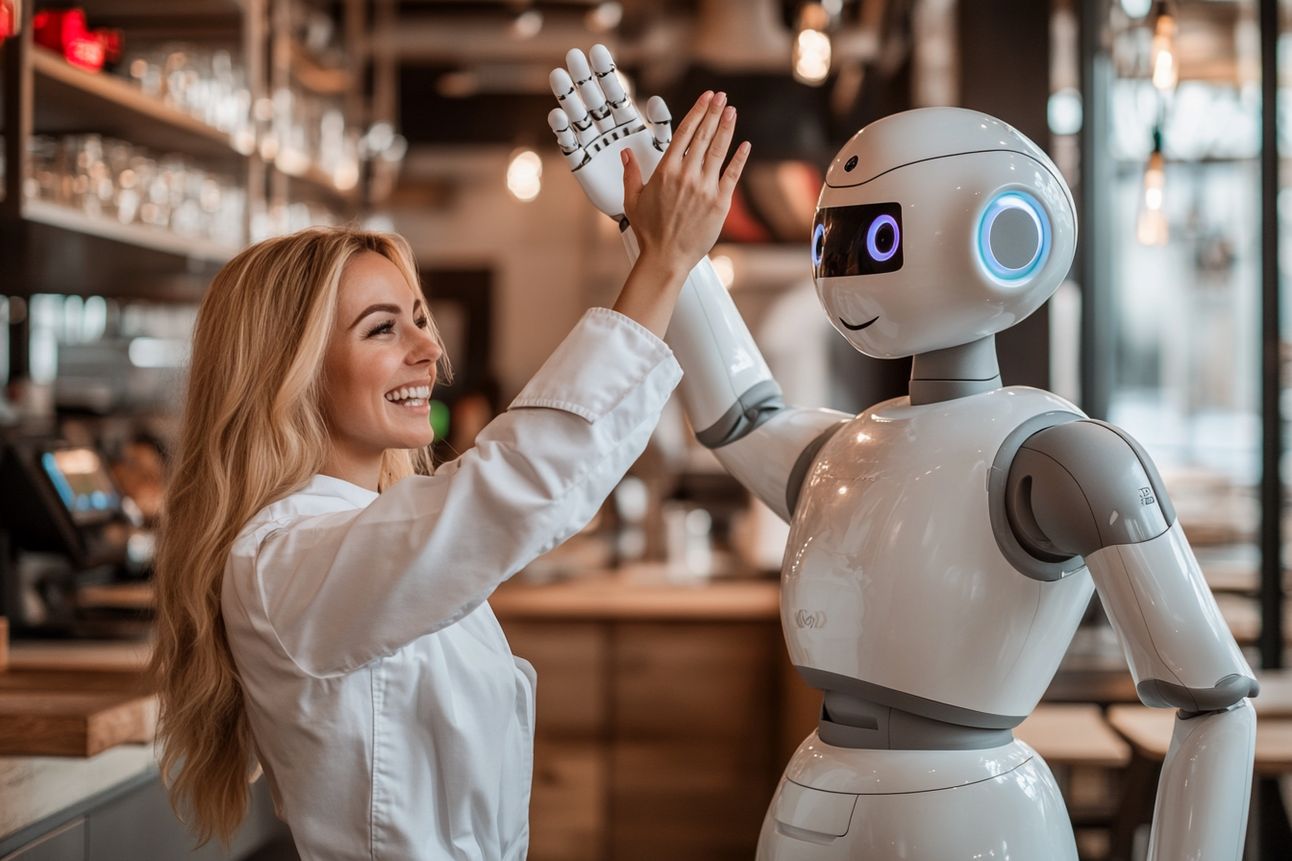
A human chef high-fives her new robotic colleague – perhaps the kitchen of the future isn’t a zero-sum game after all.
So, will AI take over the line? The honest answer: it’s complicated. In many restaurants, AI-driven robots will take over parts of the line – the frying, the flipping, the speedy assembly – but they don’t have to take over the heart and soul of the kitchen. The future likely isn’t a kitchen staffed by Terminators while humans are shown the door; rather, it could be an evolution where robots handle the grind and humans elevate the hospitality. The most forward-thinking voices in the industry keep reminding us that technology isn’t about replacing hospitality – it’s about scaling it. In other words, if we deploy robots to do the heavy lifting, it should be to give our people more bandwidth to engage, to create, to connect with guests. The human touch – grandma’s secret recipe, a chef’s creative flair, the server who remembers your kid’s name – those are the things that make dining out special, and no algorithm can truly replicate that magic (not yet, anyway).
As restaurants flirt with automation, each will have to find the line they won’t cross. Some ultra-efficient fast-food joints might edge close to full automation, essentially becoming vending machines for meals – and for a quick bite, that might be okay. But most of hospitality will likely opt for a hybrid model: robots in the kitchen, humans out front, working in tandem to deliver both efficiency and warmth. We’ve seen that when restaurants automate more, it can actually highlight the value of authentic human hospitality. Diners crave that feeling of being cared for, especially when much of the world is headed toward self-service everything. It could even be a competitive differentiator: “We have the fastest service in town thanks to AI, and the friendliest service in town thanks to our people.” That’s a one-two punch that could redefine hospitality.
There will undoubtedly be bumps in the road. We’ll grapple with how to retrain displaced workers, how to maintain the culture and camaraderie of kitchens when part of the team is metal and silicon, and how to keep the soul in the soup. But I’m optimistic. This industry has a way of absorbing change and coming out stronger (we survived the microwave revolution, the internet, delivery apps – we can survive a few friendly robots). The key is to remember why restaurants exist in the first place: to feed people and make them happy. Robots can feed us; only humans can truly make us happy doing it.
At the end of the day, a great meal isn’t just about how perfectly the onion was diced or how fast the tacos came out; it’s about the experience of being taken care of. AI can help us with the “how” – faster, cheaper, more consistent – but it’s up to us humans to preserve the “why.” As we welcome these robo-chefs into our kitchens, let’s deploy them in service of what matters: creating delicious moments and freeing ourselves to inject more hospitality, creativity, and soul into every plate. The future of flavor will no doubt have a bit of code in the recipe, but I have a feeling the secret ingredient will remain unmistakably human. Bon appétit, and don’t forget to tip your robot (and your waiter). 😉
Cheers,
Your slightly self-deprecating, definitely human narrators,
Anicia & Shane
Please let us know you feel we did with this edition: |

